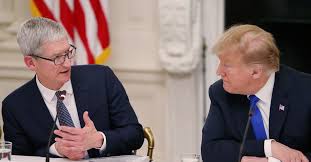In 2011, during a private dinner with Silicon Valley leaders, then-President Barack Obama posed a direct question to Steve Jobs: “What would it take to make iPhones in the United States?” Jobs’ blunt reply—“Those jobs aren’t coming back”—resonated deeply, symbolizing the broader shift in global manufacturing dynamics.
Fast forward to 2025, and the debate over bringing iPhone production to the U.S. has once again taken center stage, albeit with a different tone. Former President Donald Trump, known for his aggressive trade policies, is pushing the idea not with quiet diplomacy but with triple-digit tariff threats and viral posts on Truth Social.
Just days after slapping massive tariffs on Chinese imports—the country from where Apple sources the majority of its components—Trump claimed, “This is a GREAT time to move your COMPANY into the United States of America, like Apple, and so many others, in record numbers, are doing.”
Trump was referencing Apple’s $500 billion investment to expand its presence across the United States. However, a closer look at Apple’s 2024 global supplier list tells a different story. As per Nikkei Asia, 187 companies make up 98% of Apple’s procurement spending—and 84% of those suppliers still have a strong footprint in China, a figure that has increased since 2023.
Why Apple’s Supply Chain Still Revolves Around China
Since Trump’s initial trade war with China during his first term, Apple has tried to reduce its dependency on the Chinese supply chain. But the shift has proven far more complex than anticipated.
Tim Cook, Apple’s CEO, explained this complexity back in 2017. Speaking at the Fortune Global Forum, he dismantled the notion that China’s primary advantage was cheap labor. Instead, he emphasized China’s unmatched skill concentration:
“China stopped being the low labor cost country years ago. What sets it apart is the depth and quantity of highly skilled workers, especially in tooling. In the U.S., we’d struggle to fill a room with tooling engineers. In China, we could fill multiple football fields.”
Experts agree. Pankaj Prasad, CEO of U.S.-based tech firm Airwave, highlighted how China’s long-term infrastructure investments—roads, ports, power, factories, and millions of trained workers—have made it nearly irreplaceable.
“You get land, labor, logistics, and suppliers—all in one integrated ecosystem. That’s extremely difficult to replicate.”
Apple’s Manufacturing Footprint in the U.S.
Despite the challenges, Apple hasn’t ignored domestic manufacturing entirely. The company began assembling its Mac Pro in Austin, Texas, back in 2013 and later upgraded the facility in 2019.
In 2017, following public pressure from Trump, Apple launched a $5 billion Advanced Manufacturing Fund, aimed at bolstering innovation and job creation in the U.S. The fund supported companies like Corning (for iPhone glass) and Finisar (for Face ID components). Apple claims the fund has since doubled to $10 billion, with a growing footprint across 20 U.S. states supporting data centers, suppliers, Apple TV+ production hubs, and more.
Further developments include:
-
A 250,000 sq. ft. AI server facility under construction in Houston.
-
The Apple Manufacturing Academy in Detroit to train U.S. workers in advanced manufacturing.
However, even with these efforts, Apple remains heavily reliant on Foxconn, its Taiwanese manufacturing partner, which runs the world’s largest iPhone factory in Zhengzhou, China, employing over 200,000 workers.
The Labor Cost Dilemma
While Tim Cook argued against labor cost being a deciding factor, numbers suggest otherwise. According to the Reshoring Institute:
-
A U.S. production worker earns approx. $32,000/year
-
In China: $13,000/year
-
In Vietnam: $7,000/year
-
In India: $2,000/year
Estimates suggest that assembling an iPhone in China costs about $30 in labor, while in the U.S., that cost could spike to $300.
Cassandra Cummings (Gluyas), CEO of Thomas Instrumentation, a U.S.-based electronics firm, points out:
“In the U.S., we must offer fair wages, paid leave, healthcare, and retirement plans. In China, such benefits are not mandatory, making labor significantly cheaper.”
This cost disparity has driven many U.S. electronics firms to follow Apple’s lead in outsourcing manufacturing to China and other low-cost countries.
A Historical Shift: From California to China
Apple once proudly manufactured products in the U.S.—starting with its Macintosh in Fremont (1983) and iMacs in Elk Grove, California in 2002. But by 2004, facing financial strain and the need for efficient production, Apple shifted most manufacturing abroad, spearheaded by Tim Cook.
Cummings (Gluyas) notes that the exodus wasn’t just about cost. Strict U.S. regulations on safety, waste disposal, and industry certifications (like ISO 9001, IPC-A-610) made domestic manufacturing increasingly burdensome and expensive.
Can Tariffs Alone Bring Manufacturing Back?
According to the International Trade Centre, from 2015 to 2024:
-
U.S. electronics exports rose from $170B to $214B (26% growth)
-
China’s electronics exports jumped from $60B to $928B—a staggering 1,446% increase
Currently, China controls 25% of global electronics exports. The U.S. lags far behind at 5.9%, ranking fourth globally after Hong Kong and Taiwan.
To bridge this gap, Trump proposed raising tariffs on all Chinese goods by up to 245%. But on April 11, key sectors—including phones, semiconductors, and computers—were exempted.
In a follow-up statement on April 14, Trump said,
“I speak to Tim Cook. I helped Tim Cook recently. I don’t want to hurt anyone—but the end goal is greatness for our country.”
He had offered a similar exemption to Apple back in 2020 after direct talks with Cook.
Incentives, Not Tariffs, May Hold the Answer
Most experts argue that tariffs alone cannot build domestic manufacturing—they only raise costs for businesses and consumers.
Prasad of Airwave summed it up:
“Tariffs shift pain, they don’t solve the problem. You need strong incentives to make domestic manufacturing viable.”
This was the approach of President Joe Biden, whose administration passed the CHIPS and Science Act in 2022—a $52.7 billion initiative to boost U.S. semiconductor manufacturing.
Key beneficiaries include:
-
TSMC Arizona: $6.6B in funding + $5B loans
-
Intel: Up to $7.86B
-
Micron: $6.17B
-
Samsung, GlobalFoundries, Texas Instruments, Amkor, Corning, and others
These incentives aim to rebuild America’s semiconductor and electronics ecosystem—from raw materials to chip fabrication.
But Trump has strongly criticized the CHIPS Act, calling it “horrible” during his 2025 State of the Union address, hinting at its possible repeal.
The Bottom Line
Despite political pressure, massive investments, and growing nationalistic rhetoric, the idea of a fully “Made in America” iPhone remains far from reality.
The roadblocks—cost disparities, skilled labor shortages, regulatory hurdles, and entrenched global supply chains—are not ones that can be dismantled overnight.
Unless the U.S. combines policy incentives, long-term infrastructure planning, and skill development at scale, Apple—and companies like it—will continue to rely on China and other international partners for years to come.


